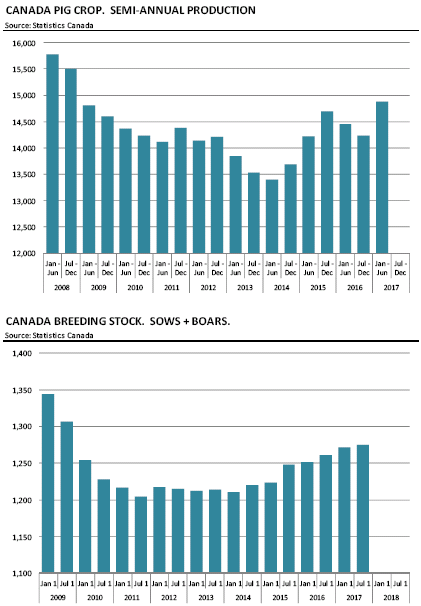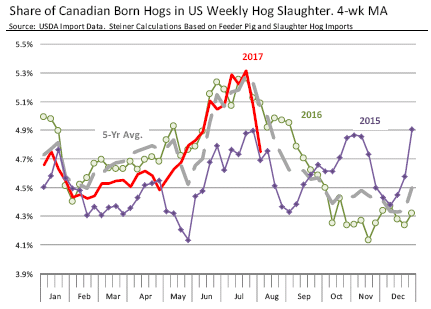



CME: Hog Supplies in Canada; Implications for US Production in H2/2017
US & CANADA - USDA last week issued a report on the combined inventory of hogs and pigs in US and Canada, reports Steiner Consulting Group, DLR Division, Inc.Over the years, the pork industry in both countries has become tightly integrated, with many Canadian hog farms focusing on breeding pigs and then sending feeders to US finishing operations. Lower feeding costs and benefits from economies of size have contributed to this division of labor.
Looking at the combined US/Canada breeding herd makes a lot of sense and you can review the report following this link. Unfortunately, the report only provides the total combined inventory rather than showing a breakdown for US and Canada.
This makes it difficult to recognise what has been happening in Canada in recent years. According to the latest report from Statistics Canada, Canadian producers are doing the same thing as their US counterparts - they are growing.
The rate of growth may be slower than in the US but they are expanding nonetheless, and this means more feeder pigs available from Canada in the next 12-18 months. The total breeding herd in Canada as of 1 July was 1.275 million head, 1.2 per cent higher than the previous year.
The US breeding herd inventory on 1 June was 6.069 million head, 1.5 per cent larger than last year. The combined US/Canada breeding hog inventory is 7.344 million head, 1.4 per cent larger than the previous year.
The increase in Canadian breeding hog numbers combined with steady gains in the number of pigs saved per litter has bolstered hog numbers in recent years. The pig crop during the period Jan-Jun of 2016 was 14.460 million head, 2.9 per cent higher than the previous year.

Keep in mind when looking at the Canadian data that StatCan reports both the number of pigs born and the size of the pig crop, which is not the same number. The pig crop is defined as the number of pigs that either were on hand or were sold during a six month period.

We cannot calculate the number of pigs saved per litter the same as we do in the US but one can look at the ratio of the pig crop relative to the breeding herd to get a sense of the improvements in productivity.
For the Jan - Jun period, the ratio stood at 11.7, a 1.7 per cent improvement compared to the previous year. Curiously, the ratio was down 4.7 per cent in the previous period, indicating either data problems or disease pressures (maybe one of our Canadian readers has a better sense of why this was).
The larger pig crop so far this year has bolstered Canadian hog exports, which come for the most part to the US as feeder pigs. Exports during Jan-Jun were 2.939 million, 58,000 head (+2 per cent) higher than a year ago.
US hog supplies have increased at a faster pace, which explains why the share of Canadian hogs in US weekly slaughter is lower than a year ago. But the larger crop and higher exports have bolstered supplies relative to 2015 & 2014, contributing to US growth.








